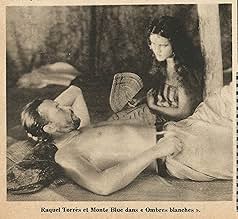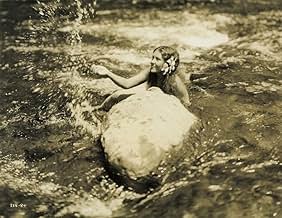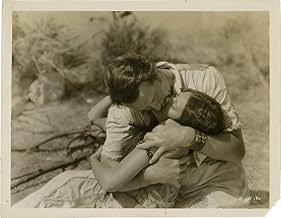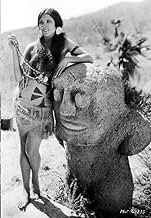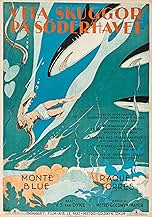AVALIAÇÃO DA IMDb
6,8/10
1,1 mil
SUA AVALIAÇÃO
Adicionar um enredo no seu idiomaAn alcoholic doctor on a Polynesian island, disgusted by white exploitation of the natives, finds himself marooned on a pristinely beautiful island.An alcoholic doctor on a Polynesian island, disgusted by white exploitation of the natives, finds himself marooned on a pristinely beautiful island.An alcoholic doctor on a Polynesian island, disgusted by white exploitation of the natives, finds himself marooned on a pristinely beautiful island.
- Direção
- Roteiristas
- Artistas
- Ganhou 1 Oscar
- 1 vitória no total
Robert Anderson
- Sebastian - a Trader
- (não creditado)
Renee Bush
- Lucy
- (não creditado)
Dorothy Janis
- Native Girl
- (não creditado)
Napua
- Native Boy
- (não creditado)
Avaliações em destaque
Over time I've noticed how much I enjoy the pace of silent movies. Not being pushed and hurried is a very welcoming experience. Also the fact, that, in between the written dialog...you only rely on the physical expressions of the actors and your own imagination. And in my opinion that allows the viewer to enjoy the movie in his or her own unique way. This holds true for all silent movies. This movie would certainly seem to have been ahead of it's time. The statement made was loud and clear. The acting was good. The underwater scenes and the context they were presented in probably had the most impact on me.
It still doesn't cease to amaze me how some Silent Movies, dramas or comedies, catch my attention so much, getting me so immersed in the plot, thus making me forget I'm watching a silent, an antique, a piece of history, enjoying the movie as I'd do with any "talking" movie.
In this case, the images are so real (it was filmed on location) and so hauntingly beautiful, that make many later Hollywood films from the 1940's or 1950's, which depict "South Seas Life" look unreal, fake, notwithstanding their possible entertainment value.
There's so much truth in this morality photo-play about a white man, identified as a "derelict" of the South Seas, previously a doctor, who finds "Paradise on Earth" (peace, love & happiness), on a certain island of the Polynesia. Monte Blue is great as this "white man".
Most of the featured players of the film, one realizes, are real natives from the islands, and this adds so much truth to the storyline. Beautiful actress Raquel Torres, does not seem (IMHO) out of place at all as Monte Blue's native love interest. And Robert Anderson is a very nasty villain.
There are some awesome underwater sequences, featuring octopuses, sharks, pearl-diving and others featuring palm-climbing, dancing, etc. Notice the different tinting (reddish, blue, sepia ...) of the sequences of the film; only at the beginning and on the end, plain black and white is used.
Great Sound score for this late "silent film", the first used for a MGM film and the first time Leo-the-Lion roared! The original South-Sea Islands Film. Excellent.
In this case, the images are so real (it was filmed on location) and so hauntingly beautiful, that make many later Hollywood films from the 1940's or 1950's, which depict "South Seas Life" look unreal, fake, notwithstanding their possible entertainment value.
There's so much truth in this morality photo-play about a white man, identified as a "derelict" of the South Seas, previously a doctor, who finds "Paradise on Earth" (peace, love & happiness), on a certain island of the Polynesia. Monte Blue is great as this "white man".
Most of the featured players of the film, one realizes, are real natives from the islands, and this adds so much truth to the storyline. Beautiful actress Raquel Torres, does not seem (IMHO) out of place at all as Monte Blue's native love interest. And Robert Anderson is a very nasty villain.
There are some awesome underwater sequences, featuring octopuses, sharks, pearl-diving and others featuring palm-climbing, dancing, etc. Notice the different tinting (reddish, blue, sepia ...) of the sequences of the film; only at the beginning and on the end, plain black and white is used.
Great Sound score for this late "silent film", the first used for a MGM film and the first time Leo-the-Lion roared! The original South-Sea Islands Film. Excellent.
The very first "sound track" film from MGM..sound effects track added by Doug Shearer, who did the sound recording on about 90% of all the old black & whites. Caption cards are still used throughout the film for the dialogue. Was also actually filmed in Tahiti, which would have been pretty rare for those times. Monte Blue ( plays Doctor Lloyd ) and Robert Anderson (the trader) had been in silent films for years, but this was Raquel Torres' ("Fayaway") first role. In our story, when pearls are discovered in the waters of the south seas, the white men move in to take advantage. The natives are up against the caucasian traders, the critters of the sea, storms, and sickness when it comes to their shores. The story is quite simple, but the outdoor and underwater photography are the high points here. Even with a respectable restoration, different scenes appear in various colors, and the lighting and sound have become slightly spotty. Interesting scenes at the feast, where prior to cooking, the fish is carefully sewn up in leaves to keep it from burning. Where others have despaired over the "documentary" feel to the film, I felt that this was one of the strengths. (Although some of those costumes and dances DO look pretty hokey.) Lloyd lives with the natives, and must decide what his long term goal is, and how to reach it. Several scenes have been sped up, which may have been an effort by "someone" to move the plot along more quickly. Or maybe just newer technology going at a different speed. Directed by WS Van Dyke, produced by Thalberg and Stromberg, all pretty big cheeses in the industry at the time.
Woody Van Dyke was a prolific director, with many well-loved and classic movies helmed by him. "White Shadows in the South Seas" is one of his best, showing a mastery of camera use and a skill in leading his cast.
Monte Blue was, likewise, a very prolific actor, but his lead role here has to be one of his best, and one of his best performances. He was very affecting, very touching, and even handled the pre-Yakima Canutt fight scenes well.
There is a realism to this movie that caught my attention, even though I am very familiar with the silent genre, having been, for example, a regular for years at the old Silent Movie Theatre in Los Angeles when it was run by the great John Hampton.
As others have commented here, the beauty of the location joined with the quality of the acting and directing make this masterpiece a cinematic experience, and I urge everyone to grab any opportunity to watch it.
Monte Blue was, likewise, a very prolific actor, but his lead role here has to be one of his best, and one of his best performances. He was very affecting, very touching, and even handled the pre-Yakima Canutt fight scenes well.
There is a realism to this movie that caught my attention, even though I am very familiar with the silent genre, having been, for example, a regular for years at the old Silent Movie Theatre in Los Angeles when it was run by the great John Hampton.
As others have commented here, the beauty of the location joined with the quality of the acting and directing make this masterpiece a cinematic experience, and I urge everyone to grab any opportunity to watch it.
How nice is it to see this treatment, this attitude, of the white man's imperialism towards native cultures in the 19th century, especially when other movies from this time period often had such blatant or casual racism. Here we clearly see the white man as the bad guy, greedy for pearls, exploiting the Polynesians, and spreading disease. It may be over the top and idealized at times, with some non-factual bits such as attacking octopi and grand proclamations against the white race as a whole, but its heart was certainly in the right place, and this notion of which party was evil was certainly correct.
Filmed on location in the Marquesas (or perhaps in reality Tahiti), it shows beautiful footage of the islands as well as the culture, such as people dancing, scaling coconut trees, shaving breadfruit, diving, fishing, and making fire. I'm not an expert but it feels authentic, and without a doubt, it's certainly respectful of the indigenous people. Director W.S. Van Dyke ("One Take Woody", who would go on to an Oscar nomination for "The Thin Man") pulls all the right strings here, from a fantastic typhoon scene, to intimate moments between leading man Monte Blue, and an island woman played by Raquel Torres. Most of the rest of the cast consists of real Islanders. Cinematographer Clyde De Vinna was worthy of the Oscar he won for the visual treats he gives us throughout the movie, and we also get a few bits of sound on MGM's first film with a pre-recorded soundtrack. What a hidden gem this film is for 1928.
Filmed on location in the Marquesas (or perhaps in reality Tahiti), it shows beautiful footage of the islands as well as the culture, such as people dancing, scaling coconut trees, shaving breadfruit, diving, fishing, and making fire. I'm not an expert but it feels authentic, and without a doubt, it's certainly respectful of the indigenous people. Director W.S. Van Dyke ("One Take Woody", who would go on to an Oscar nomination for "The Thin Man") pulls all the right strings here, from a fantastic typhoon scene, to intimate moments between leading man Monte Blue, and an island woman played by Raquel Torres. Most of the rest of the cast consists of real Islanders. Cinematographer Clyde De Vinna was worthy of the Oscar he won for the visual treats he gives us throughout the movie, and we also get a few bits of sound on MGM's first film with a pre-recorded soundtrack. What a hidden gem this film is for 1928.
Você sabia?
- CuriosidadesAfter completing filming on the tropical island, they returned to the MGM lot at Culver City, where W.S. Van Dyke shot some additional material, including a typhoon at sea and a shipwreck. Then the studio decided to make Deus Branco (1928) their first sound film, so they added a synchronized soundtrack consisted of a romantic score by William Axt and David Mendoza, with a few sound effects such as wind howling, a storm, trees ruffling and the words "Hello" and "wait."
This was MGM's first sound picture, and it premiered in Hollywood at Sid Grauman's Chinese Theater on Friday, 3 Aug 1928. It is known for being the first MGM film to be released with a pre-recorded soundtrack.
- Erros de gravaçãoThe drowned young man's left arm moves by itself.
- Citações
Dr. Matthew Lloyd: For God's sake, go away, Sebastian... these people are like birds... like flowers... they are like man was before he lost the Garden of Eden...
- Versões alternativasThere is an Italian edition of this film on DVD, distributed by DNA srl, "L'UOMO DI ARAN (1934), NANUK L'ESCHIMESE (1922), OMBRE BIANCHE NEI MARI DEL SUD (1928)" (3 Films on a single DVD), re-edited with the contribution of film historian Riccardo Cusin. This version is also available for streaming on some platforms.
- ConexõesFeatured in Settling the Score (2005)
- Trilhas sonorasFlower of Love
(1928) (uncredited)
Music by William Axt and David Mendoza
Lyrics by Dave Dreyer and Herman Ruby
Principais escolhas
Faça login para avaliar e ver a lista de recomendações personalizadas
- How long is White Shadows in the South Seas?Fornecido pela Alexa
Detalhes
- Data de lançamento
- País de origem
- Idioma
- Também conhecido como
- White Shadows in the South Seas
- Locações de filme
- Empresas de produção
- Consulte mais créditos da empresa na IMDbPro
Bilheteria
- Orçamento
- US$ 365.000 (estimativa)
- Tempo de duração1 hora 28 minutos
- Mixagem de som
- Proporção
- 1.20 : 1
Contribua para esta página
Sugerir uma alteração ou adicionar conteúdo ausente


